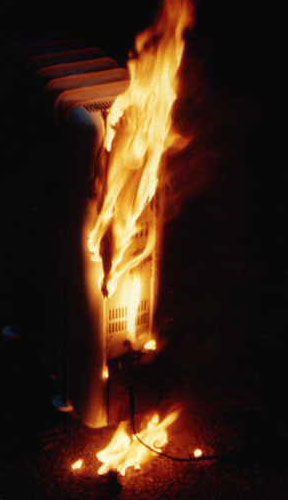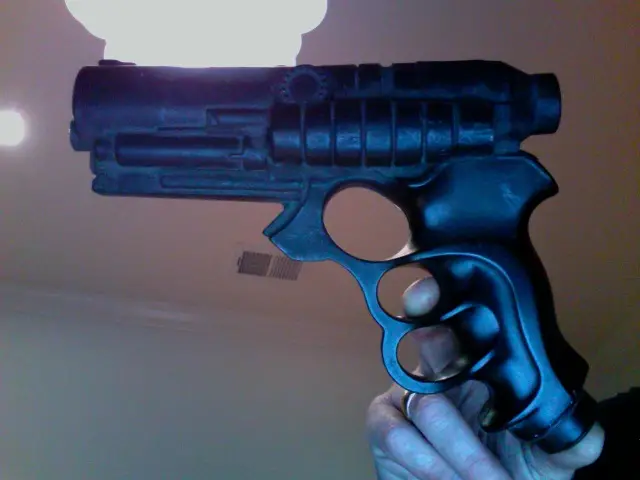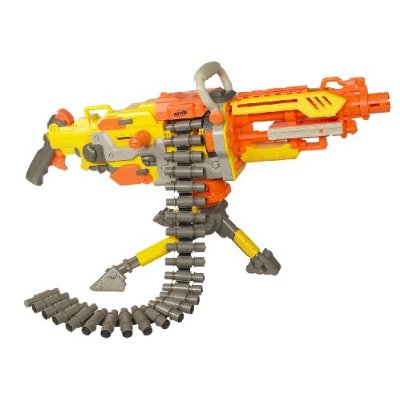


Terrorizing Innocent Hunting and Shooting Enthusiasts with Plastic

Plastic sights, plastic stocks. Plastic breeches, plastic blocs. Rounded grips, plastic belted. Fire it once, the darn thing's melted.
The unspeakable horror of plastic has infected many industries but it is its flagrant, shameless use that has condemned many of today's firearms to flounder with all the heirloom quality of a Bic pen. It is one thing to put the plastic lid on your garbage can but quite another to grind up a garbage can lid and attempt to make a gun out of it. Recycling is a good thing, but a new gun that looks like it needs to be recycled immediately it is a different matter.

Naturally, it is hardly manufacturers that are solely to blame. If savvy consumers rejected plastic for no reason, passed on the polymer without purpose, and tap-danced away from tupperware without taste, the landscape would be different. For the time being, though, there is an overabundance of composite without cause.
Distinction should be made between plastic for the sake of cheap against the tapestry of build materials that do offer tangible advantages in performance. The plastic stock is as good an example as anything. You've all seen hollow, cheap, blow-molded stocks on shotguns and rifles. They are noisy, mostly hollow except perhaps for a cheap piece of foam shoved in the buttstock. Slippery and greasy, they cannot easily be bedded. Called “composite,” they are more like a composite of melted-down milk jugs than anything else. They add nothing to hunting and shooting, just more of the unspeakable horror of being cheap, flimsy, and breathtakingly ugly. Laminated stocks, as a class, are stronger, more accurate, and more weatherproof than many plastic attempts. Strength, rigidity, and weatherproofing is why they were first made. Formed with high pressure, heat, and glue their only negative is their weight, which may not be a negative at all depending on application. While the furniture aficionado may rightly scoff at laminated wood as offensive to his delicate sensibilities, it is stronger and more weatherproof than standard walnut, so its use has purpose and benefit.
Often, it gets to the point where the assumption is made that plastic is better for wet conditions or that wood doesn't belong in the hunting woods. What is more natural in the woods, wood itself or highly polished plastic made by old world craftsmen? After all, lumber comes from trees and plastic comes from the stuff currently coagulating in the Gulf of Mexico. Looking at a majestic ship such as the U.S.S. Constitution, nowhere on this wooden beauty is the warning “keep away from water or wet conditions” anywhere to be found. They just don't make three-masted wooden frigates like they used to.

The majestic U.S.S. Constitution. You won't find a series of "keep away from water" warnings anywhere on the hull.
There are exceptions that prove the rule. Ruger's LCR is anything but wondrously attractive and superbly easy on the eyes in any conventional sense. Who has the prettiest concealed weapon isn't something that is going to be easily seen or appreciated. In the case of the Ruger LCR, the lightweight, corrosion resistance, and soft-shooting qualities provide the advancement in portability and serviceability, if not dashing good looks. The same can be said for the purposeful Glock, the autoloading pistol standard in the minds of many.
In the end, the only consumer vote that ever counts, the vote with the wallet, will determine what the future brings. We can all carp about “they don't make them like they used to” (often a very good thing) but if we really want tasteful guns made of authentic materials, someone is going to have to start buying them. We aren't doing that. Small wonder that thick plastic with visible mold lines, rough, poorly polished and crude matte finishes often win the day. They only win because that is what we buy.
The terror of plastic is a terror that we have decided to fund. There is nothing inherently bad about any firearm, regardless. Just because a gun is crude-looking, crumpled-looking, or void of any aesthetic qualities does not make it a bad thing. Just because you have a good-looking dog doesn't mean it can hunt, either.
However, there is a responsibility that we have, if we want to elevate the opinion of the general public about hunting and shooting, to present ourselves in a manner we can be proud of. I'm not at all referring to the elitism and snobbishness that has infected too many gun clubs as is. That's a different topic altogether.

The belt fed, three dart per second Nerf N-Strike Vulcan EBF-25 Blaster.
I'm referring to guns that are made solely to look mean, intimidating, or cartoonish. The big and bad went south in the modern age along with flaming skull decals. Effort has been made to offer toy guns, squirt guns, and paintball guns look mean, bad, or pathetically ridiculous contingent on your point of view. I'm all for the goofiest looking Super-Soaker or rubber-band gun possible. Nevertheless, if we choose to use firearms that look like they came from the circus, we can hardly expect the non-shooting public to consider us as less than clowns.
The categoric dismissal of the new, the novel, the unconventional is unfair as well. It is the worst type of type of judging a book by its cover. At the same time there are fundamental attributes to build quality. Stamped parts are still stamped, unpolished still means unpolished, and no matter how you try to call parts made from ground-up garbage can lids “tactical” when the only tactics present are trying to find new ways to sell ground-up garbage can lids and milk jugs.
So, if we want well-crafted, aesthetically pleasing firearms, there is a simple solution. We have to buy them. Again, there is no such thing as a “bad” gun, so long as the gun functions safely and does what you want it to do. If we want to elevate the view of hunters and shooters as gentleman and sportsman, presenting ourselves and our equipment with taste and grace is all a part of the picture.
Copyright 2010 by Randy Wakeman. All Rights Reserved.

Custom Search

